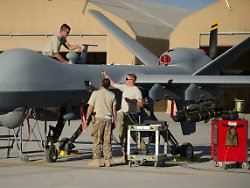Sunday 19th December 2021
Drone Wars in the Middle East
Report: US air strikes killed thousands of civilians
The “New York Times” puts the American air war in an even darker light than it already was. A significantly larger number of civilians than previously thought are said to have been killed in air strikes, according to the newspaper. The reason: incorrect analyzes, poor image quality, hasty attacks.
According to a report in the New York Times, the USA negligently accepted the devastating consequences for the civilian population in its drone war in the Middle East. So reports the newspaperthat a number of confidential government documents, including more than 1,300 reports of civilian casualties, refute the government’s account of a “precision strike” war against jihadists. Accordingly, the air strikes are characterized by errors and thousands of civilian deaths.
“The American air war was marked by inadequate reconnaissance, hasty and inaccurate rocket launches and the deaths of thousands of civilians, including many children,” reports the newspaper. The transparency promises from the time of Barack Obama, who was the first US president to prefer drone strikes in order to save the lives of US soldiers, have been replaced by “opacity and impunity”. “Not a single report concluded that there was misconduct”.
In five years, the US Army has carried out more than 50,000 air strikes in three countries: Syria, Afghanistan and Iraq. She has admitted that she has accidentally killed 1,417 civilians in air strikes in Syria and Iraq since 2014. In Afghanistan, the official number is 188 civilians killed since 2018. The newspaper’s research showed, however, that the numbers admitted by the Pentagon were “clearly understated”.
Disastrous misidentifications
Accordingly, the US armed forces were often wrong in their assessments of the targets of air strikes. People who ran to a bombed site were seen as fighters for the Islamic State group and not as helpers. “Simple motorcyclists” were identified as riding “in formation”, which was interpreted as a “sign” of an impending attack.
According to the Pentagon documents, misidentification only made up four percent of cases involving civilian victims. The field study carried out by The Times shows, however, that there were errors in 17 percent of the incidents investigated and that almost a third of the civilian deaths and injuries were caused by these errors.
Cultural ignorance also played a role. For example, the US military ruled that a house they were monitoring on a day of the fasting month of Ramadan had “no civilians” even though several families slept there during the day to protect themselves from the heat.
Poor image quality or observation periods that were too short also contributed to misjudgments when reviewing reports from civilian casualties. Of the 1,311 cases investigated by the New York Times, only 216 were rated “credible” by the Pentagon. Reports of civilian casualties were rejected because the videos did not show any bodies in the rubble or because the footage was not long enough to allow conclusions to be drawn.
A spokesman for Central Command told the newspaper that “even with the best technology in the world, mistakes happen, whether through incorrect information or misinterpretation of the information available.” The military is doing “everything to avoid harm”. It investigates every “credible” case. “We regret every loss of an innocent life”.
